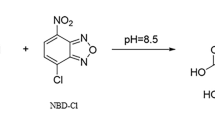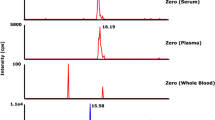Abstract
A highly selective, sensitive, and reliable high-performance liquid chromatography (HPLC) method was developed and validated for the simultaneous determination of a novel type of dopamine receptor antagonist LE300 and its N-methyl metabolite in mouse sera. LE300, its N-methyl metabolite, and verapamil (an internal standard) were detected using excitation and emission wavelengths of 275 and 340 nm, respectively. HPLC analysis using a deproteinization procedure was performed by injecting an aliquot of the supernatant into the chromatographic system. Chromatographic separation was achieved on a reversed-phase Spherisorb Cyano (CN) column with a mobile phase consisting of acetonitrile:50 mM phosphate buffer pH 3.5 (70:30, v/v) pumped at a flow rate of 1.0 mL min−1. Regression analyses showed excellent linearity (r = 0.999) for concentrations of LE300 ranging from 4 to 500 ng mL−1 and for concentrations of its N-methyl metabolite of 6–600 ng mL−1. The HPLC-FLD method had limits of detection of 1.6 ng mL−1 for LE300 and 2.4 ng mL−1 for its N-methyl metabolite in mouse sera. The precision results, expressed as the intraday and interday relative standard deviation (RSD) values, ranged from 0.65 to 2.85 % (repeatability) and from 0.37 to 2.62 % (intermediate precision) for LE300 and its N-methyl metabolite, respectively; these values are in line with ICH guidelines. The assay was successfully applied in a pharmacokinetic study. The mean values of T max and C max were 2 h and 25.03 ± 5.60 ng mL−1 for LE300 and 3 h and 19.92 ± 2.88 ng mL−1 for its N-methyl metabolite, respectively.



Similar content being viewed by others
References
Decker M, Schleifer KJ, Nieger M, Lehmann J (2004) Eur J Med Chem 39:481–489
Hoefgen B, Decker M, Mohr P, Schramm AM, Rostom SAF, El-Subbagh H, Schweikert PM, Rudolf, Kassack MU, Lehmann J (2006) J Med Chem 49:760–769
Kassack MU, Höfgen B, Decker M, Eckstein N, Lehmann J (2002) NauSchmi Arch Pharm 366:543–550
Emilien G, Maloteaux JM, Geurts M, Hoogenberg K, Cragg S (1999) Pharmacol Ther 84:133–156
Robaa D, Kretschmer R, Siol O, AbulAzm S, Elkhawass E, Lehmann J, Enzensperger C (2011) Arch Pharm Chem Life Sci 1:28–36
Hubert P, Nguyen-Huu JJ, Boulanger B, Chapuzet E, Chiap P, Cohen N, Compagnon PA, Dewe W, Feinberg M, Lallier M, Laurentie M, Mercier N, Muzard G, Nivet C, Valat L, Rozet E (2007) J Pharm Biomed 45:70–81
Sennbro CJ, Knutsson M, Timmerman P, van Amsterdam P (2011) Bioanalysis 3:2389–2399
González O, Blanco ME, Iriarte G, Bartolomé L, Maguregui MI, Alonso RM (2014) J Chromatogr A 1353:10–27
ISO (2005) ISO/IEC17025: General requirements for the competence of testing and calibration laboratories. International Organisation for Standardisation, Geneva
ISO (2012) ISO/IEC15819: Medical laboratories—particular requirements for quality and competence. International Organisation for Standardisation, Geneva
US FDA (1999) Draft guidance for industry: bioanalytical method validation. US Food and Drug Administration, Rockville
Gibson GG, Skett P (2001) Introduction to drug metabolism. Nelson Thornes, Cheltenham
ICH (1996) Q2B validation of analytical procedures: methodology. International Conference on Harmonization (ICH), Geneva
Miller JC, Miller JN (2005) 2nd edn. Ellis Horwood, Chichester
Acknowledgments
The authors extend their appreciation to the Deanship of Scientific Research at King Saud University for funding the work through the research group project no. RGP-VPP-037.
Conflict of interest
The authors declare that they have no conflict of interest.
Author information
Authors and Affiliations
Corresponding author
Rights and permissions
About this article
Cite this article
Hefnawy, M., Alanazi, A., Abounassif, M. et al. Selective Analysis of Dopamine Receptor Antagonist LE300 and its N-Methyl Metabolite in Mouse Sera at the Trace Level by HPLC–Fluorescence Detection. Chromatographia 78, 655–661 (2015). https://doi.org/10.1007/s10337-015-2879-x
Received:
Revised:
Accepted:
Published:
Issue Date:
DOI: https://doi.org/10.1007/s10337-015-2879-x




